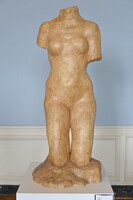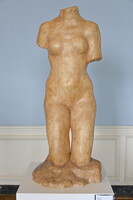| dc.coverage.spatial | Site: Musée Rodin (Paris, Île-de-France, France) S.3984 | en_US |
| dc.coverage.temporal | 1909 (creation) | en_US |
| dc.creator | Rodin, Auguste | en_US |
| dc.date | 1909 | en_US |
| dc.date.accessioned | 2015-01-06T15:10:46Z | |
| dc.date.available | 2015-01-06T15:10:46Z | |
| dc.date.issued | 1909 | en_US |
| dc.identifier | 256344 | en_US |
| dc.identifier.other | archrefid: 3025 | en_US |
| dc.identifier.uri | http://hdl.handle.net/1721.3/172296 | |
| dc.description | Overall view from front; Rodin sought to explore the creative potential of enlarging his works. This involved using a pantograph, a mechanical device originally designed to scale down sculptures for edition purposes, but it can also be used for the opposite effect, to scale up a model. Rodin first came across this device in the late 1890s, and began enlarging figures that he had designed for the Monument to Victor Hugo. In 1910, Rodin exhibited Torso of a Young Woman with Arched Back alongside The Prayer, both of which were enlargements of motifs from The Gates of Hell. Donated to the museum by Rodin in 1916. Source: Musée Rodin [website]; http://www.musee-rodin.fr/en/ (accessed 5/13/2014) | en_US |
| dc.format.medium | patinated plaster | en_US |
| dc.rights | © Scott Gilchrist, Archivision, Inc. | en_US |
| dc.subject | human figure | en_US |
| dc.subject | Twentieth century | en_US |
| dc.title | The Prayer | en_US |
| dc.title.alternative | La Priere | en_US |
| dc.type | image | en_US |
| dc.rights.access | Licensed for educational and research use by the MIT community only | en_US |
| dc.identifier.vendorcode | 7A1-RA-TP-A01 | en_US |
| vra.culturalContext | French | en_US |
| vra.technique | modeling (forming) | en_US |
| vra.worktype | sculpture (visual work) | en_US |
| dc.contributor.display | Auguste Rodin (French sculptor, 1840-1917) | en_US |


